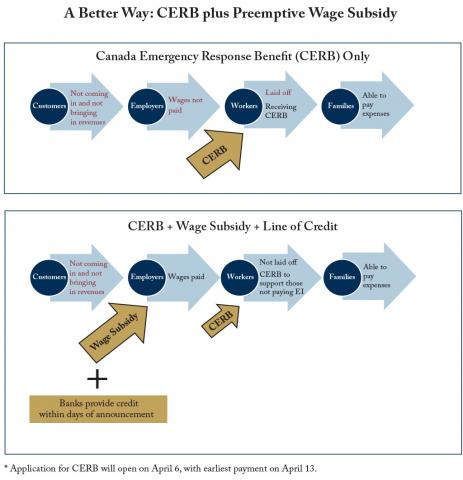To: Deputy Prime Minister Chrystia Freeland, Federal Finance Minister Bill Morneau, Minister of Minister of Families, Children and Social Development Ahmed Hussen, and Jean-Yves Duclos, President of the Treasury Board
From: Benjamin Dachis, Grant Bishop and William B.P. Robson
Re: An ounce of layoff prevention is worth a pound of income-support cure
Date: March 27, 2020
Rapid substantial support for jobs is a critical missing piece of the federal government’s response to the COVID-19 crisis.
Across the economy, businesses and not-for-profits are losing revenue and laying off workers. The chain reaction is a major reason that a deep recession and double-digit unemployment are anticipated.
A subsidy for workers still on the job would complement the Canada Emergency Response Benefit (CERB). At a minimum, Ottawa could deliver Employment Insurance (EI)-sized benefits through employers. Or it could go bigger – up to 75 percent, say, as Ireland has done.
As a practical matter, “reversing the flow” of EI remittances through employers will take time. So the federal government should bridge the gap through government-backed lines of credit (GBLOCs). An employer could access credit equal to the wage subsidy from a bank or credit union. Lenders would be able to establish GBLOCs within days.
Yesterday, the C.D. Howe Institute’s Crisis Working Group on Business Continuity and Trade endorsed both wage subsidies and a “bridge” of GBLOCs. Here’s why:
- Under Ottawa’s current plan, CERB applications will start April 6 and money would flow 10 days later. GBLOC-supported wage subsidies will be far faster. Employers already have financial relationships with the institutions that would extend credit.
- EI-sized wage subsidies will reduce demand for both EI and the CERB. EI provides weekly benefits of 55 percent of wages up to a $54,200. Equivalent support to a firm that otherwise would lay a worker off costs the same. Support at the 55-percent level would cost about $4.5 billion a week. Support at 75 percent would cost about $6.3 billion a week. If 4 million individuals receive CERB (as anticipated) at $2,000/month, the cost would be $2 billion a week. Maintaining wages will stem the requirement for workers to seek the CERB, reducing the cost of that program.
- The wage subsidy can use up-to-date information. Employers collect and remit contributions weekly or biweekly. The CERB will rely on income-tax filings, mostly from 2018, to send cheques. Much of that information will be out of date. Fewer layoffs will also reduce administrative strain on CERB applications.
- Wage subsidies are targetable. They could be limited to businesses and not-for-profits that experience a sizeable drop in revenue (Ireland’s wage subsidy specifies a 25-percent revenue decline) and require a commitment that the employer limit or avoid layoffs.
- Working through employers will keep employees connected during any downtime – good for morale and mental health. The CERB forces an employer to lay someone off or stop paying wages.
Narrower targeting and more specific plans for recouping overpayments make sense in principle, but time is pressing. The Canadian Federation of Independent Business’s mid-March member survey indicated that half are contemplating layoffs.
The federal government can do more to stop the trauma of the COVID-19 crisis. Government-backed lines of credit and a wage subsidy should be top priorities.
Ben Dachis is director of public affairs, Grant Bishop is associate director, research, and William B.P. Robson is president and CEO of the C.D. Howe Institute
To send a comment or leave feedback, email us at blog@cdhowe.org.
The views expressed here are those of the authors. The C.D. Howe Institute does not take corporate positions on policy matters.






